When choosing the roof for your log cabin, practicality is as important as being stylish.
- Brown Finished Metal Roof to Enhance the Mountain Style of the Log Cabin
- Rusty-Colored Cor-ten Gabled Roof of a Log Cabin
- Classic Gable Roof Made of Slate in Brown Color for a Log Cabin
- Cedar Shingles and Corrugated Cor-ten Steel Log Cabin Roof in a Rustic Style
- Mixed Materials for a Traditional Log Cabin Roof
- Hip Metal Roof in Bronze Finish for a Small Log Cabin
- An Asphalt Shingle Roof in Slate Black Color for a Three-story Log Cabin
- Standing Seam Metal Roof in Patina Finish for a Log Cabin
- Corrugated Metal Roof in Green Color for a Large Log Cabin
- Worn-out Steel Log Cabin Roof in a Rustic Style
- Combination of Cedar Shakes and Metal Roof in a Log Style Cabin
- Slate Log Cabin Roof in Gable Style
- Englert Kynar Ultra-Cool Low Gloss Metal Log Cabin Roof
- Green Painted Metal Log Cabin Roof
- Choosing Materials for Log Cabin Roof
Log cabins are usually located in a colder area, and some of them are situated in the woods. It means that you need a kind of roof that can protect you from nature, especially rain and snow.
Choosing the right roof, be it the style and materials, can play a big role in your log cabin’s style. It affects how the cabin feels on the inside.
Actually, there are various roof styles that can adorn the top of your cabin, from hip, gable, to gambrel roof.
However, a gable roof is the most commonly used roof for log cabins. The reason is simply that a gable roof can optimize the amount of space upstairs; thus, it can provide you with more rooms for storage or architectural features.
Keep in mind that certain roof styles may be more suitable in some areas than others. The weather plays a part in the choice of roof.
On an Appalachian cabin, the roof usually comes in a 12/12 pitch with a 45-degree angle or a 10/12 pitch with a 40-degree angle pitch to efficiently shed snow and rain.
In the areas where it snows a lot, it’s better to choose the roof that can keep the snow on it, so it doesn’t build up around the log cabin. In those areas, the typical roof is 8/12 with a 34-degree or 6/12 pitch with a 27-degree angle.
Still not sure what to add on top of your log cabin? Here are some popular log cabin roofs that you can choose to protect your property from rain and snow:
1. Brown Finished Metal Roof to Enhance the Mountain Style of the Log Cabin

Mountain style is actually just another name for rustic. We can see how well the designer applied every single element for this log cabin to represent a mountain style or rustic.
The roof, log siding, and even the front stairs are finished in brown color. There’s also a stone element used for the chimney to enhance the mountain-style look. The dark brown color is part of the classic Adirondack palette.
Instead of sticking with dark brown, the designer also added a splash of color, which is bright red, for the window and door trim. The red color doesn’t only contrast the log siding but also the roof at its top. It looks pop against the dark brown canvas.
The gable roof is made of metal. Even though metal roofing is more expensive than other materials, many people have now started using metal roofs for their log cabins.
Despite the price, rain on a tin roof delivers a soothing sound that can usually be found on white noise machines or meditation apps.
But surely that’s the main reason why people rely on a metal roof for a log cabin. Compared to traditional asphalt shingles, a metal roof is far more long-lasting and durable. Its lifespan is always on top of the benefits.
If you think that metal roof is too modern for your rustic log cabin, you can simply just finish it in brown color. Match your roof to the log siding by using the same coat to create cohesion.
A metal roof in dark brown color like this still exudes a warm and cozy look a log cabin usually has.
2. Rusty-Colored Cor-ten Gabled Roof of a Log Cabin
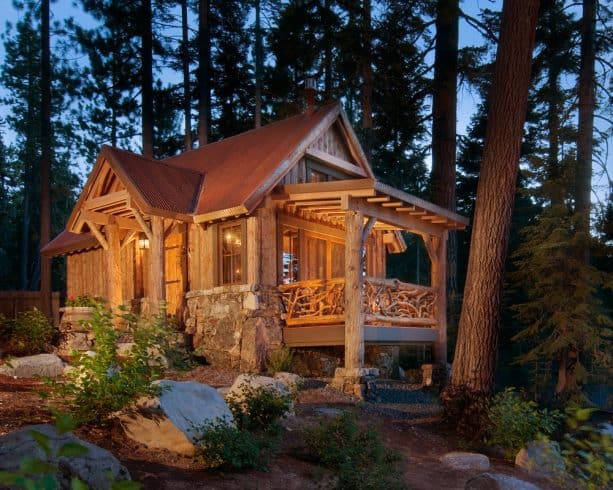
This cozy little log cabin also has a perfect rustic style, similar to the previous pictures. The difference is, the designer chose an unfinished and untreated roof.
The gable style is an excellent pair for a log cabin, but what about the material?
It does appear that this roof is made of Cor-ten steel. Cor-ten steel is a low-alloy but has a high-quality strength for outdoor steel. It’s part of the groups of “Weathering Steel” used for its incredible resistance to corrosion.
Cor-ten steel is designed to get a rusty appearance, so there is no need to paint it.
Cor-ten steel is quite popular as a roofing material for a log cabin because it has a striking rustic appearance even though it’s not finished in dark brown color. The rusty color is its natural shade.
This kind of roof is low maintenance, so you don’t have to worry about replacing it every once in a while. The rust on them creates a protective layer that reduces the overall rate of corrosion.
Due to the fact that it doesn’t need to paint, cor-ten steel roofing is the most economical solution if you want a low-maintenance roof. Plus, it fits nicely with the log siding.
3. Classic Gable Roof Made of Slate in Brown Color for a Log Cabin
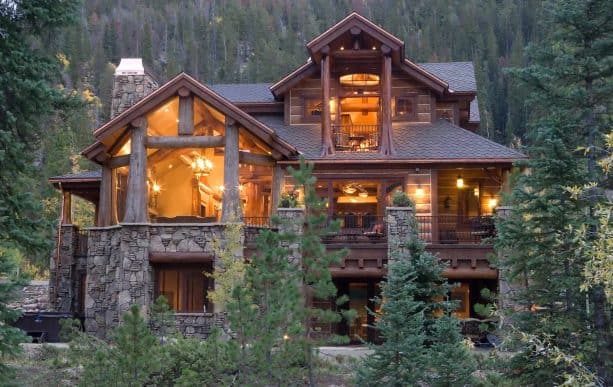
A Gable roof is indeed the most common option when it comes to the log cabin. This one is no different.
This log cabin features a classic gable roof that makes the whole log cabin look cozy and warm, rustic look at its finest. To match the western red cedar log walls, the designer carefully picked the roof material finished in brown.
It appears that this roof is made of slate. Even though it may be a bit outdated to use a slate roof for a log cabin these days, we can’t deny that there are many reasons why people still stick to the traditional-looking slate. One of them is because slate is energy efficient.
FYI, the slate is considerably very dense. It can make your log cabin cooler during the summer by preventing hot air from coming to your home, even your attic.
During the winter, the dense and heavy material of slate also prevents warm air inside from escaping outside. In summer or winter, slate helps you save more on your cooling and heating bills.
It seems that this log cabin is situated in a colder area, deep in the woods. It may not be too hot during the summer, but the winter can be extreme. Thus, installing a slate roof is actually a great idea.
4. Cedar Shingles and Corrugated Cor-ten Steel Log Cabin Roof in a Rustic Style
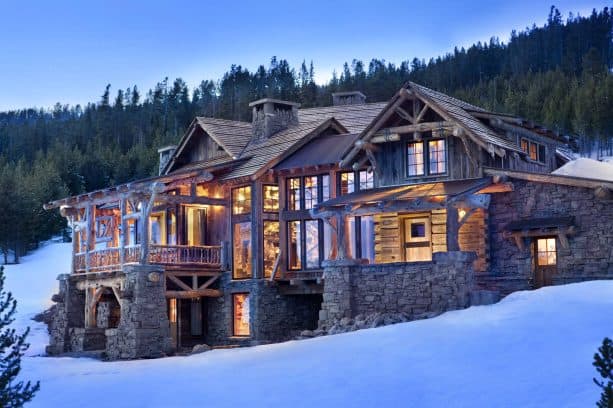
This is another rustic log cabin.
Instead of adding a splash of color to the exterior, the designer decided it would be better for a log cabin to stay true to the traditional rustic design with brown color. The only accent element used here is the stone, which is Harlowton Stone.
This log cabin also features a roof in gable style, and it is made of cedar shingles and corrugated cor-ten steel with a doubled 5th course.
At some parts, the designer used cor-ten metal roofing instead of cedar shingles for an efficiency reason.
Corrugated cor-ten steel is also known as weathering steel. It has a beautiful look with a naturally oxidizing finish that makes it look like rusted roofing, perfect for a rustic style.
Despite the rustic and traditional look it offers, there are many other reasons why people use cedar shingles on a log cabin these days. This kind of roof can maintain its original dimensions in humid conditions. Thus, it won’t shrink.
Contrary to slate, cedar wood is a material with a considerably low density offering minimal shrinkage. It makes for lasting installations because it holds fastening tightly, stays straight, and lies flat.
And for the metal roof, it seems that parts of the house with metal roofing are meant to hold the snow that slides down from the cedar roof. Therefore, the snow won’t build up around the log cabin.
5. Mixed Materials for a Traditional Log Cabin Roof
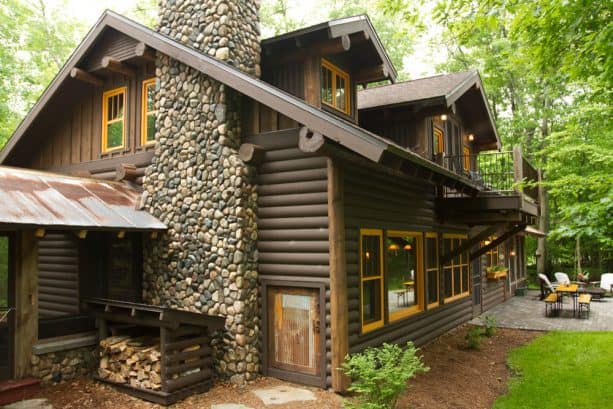
This log cabin has mixed materials for the roofing. Metal roofing is used in one part of the house, while the rest of it seems to have a traditional asphalt shingle roof.
It may seem a bit counterproductive to use asphalt shingle as a log cabin roof these days. But, many people still like the traditional appearance it exudes.
Despite the traditional appearance, asphalt shingles are so far the most affordable roofing material on the market.
Compared to other more updated materials, asphalt shingles are perfect for you if you’re tight on the budget. Plus, asphalt shingles are quick ad easy to install.
Contrary to popular belief, asphalt shingles are not that bad. If they’re installed properly and correctly, they can last for about 25-30 years, which is quite a long time.
If you want to replace your asphalt shingles, they are also easy to replace. Repairing them is also an easy thing to do.
One of the reasons why they are very affordable on the market is that they don’t need any special tools to install, like wall terminations, vent flashings, or roof edges.
Asphalt shingles are versatile, so they are open to many different styles, shapes, and colors. See how the roof here is perfectly formed in a gable style. It’s not only that, but the roof is also finished in brown color to match log siding.
The most important thing is, on a log cabin where snow and rain sometimes become an issue, asphalt shingles have proven great as a protector.
6. Hip Metal Roof in Bronze Finish for a Small Log Cabin
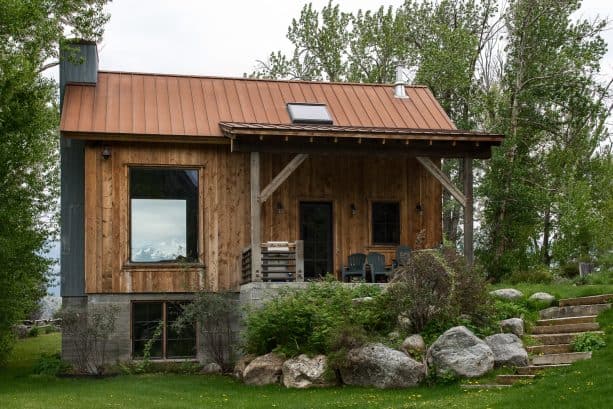
Instead of a gable, this log cabin features a hip roof, which is a bit uncommon for a log cabin but not too odd either.
The roof is made of metal, which is actually a modern material when it comes to the roof log cabin.
The designer also painted the metal in a bronze finish to mimic a traditional rustic look.
Rusty color itself is an excellent option for a rustic look. But, the designer also created a subtle contrast of the roof and the siding. Both of them have brown colors but in a different shade. This delivers a lovely visual, especially in a small cabin.
Why is it better to install a metal roof in a small log cabin?
It’s because metal is lightweight. Compared to other traditional roofing materials, like concrete tiles, a metal roof is very much lighter.
The metal roof weighs around 50-150 pounds per square, which makes it is easy to install. When installing a metal roof, you don’t have to build the supporting structure, which helps you save more.
Plus, the lightweight metal roof won’t overwhelm the small building. That’s why it’s better for such a small log cabin.
Imagine if you use a heavier traditional material for your small log cabin roof. It will create a hideous unbalanced look, making the log cabin look too heavy.
7. An Asphalt Shingle Roof in Slate Black Color for a Three-story Log Cabin
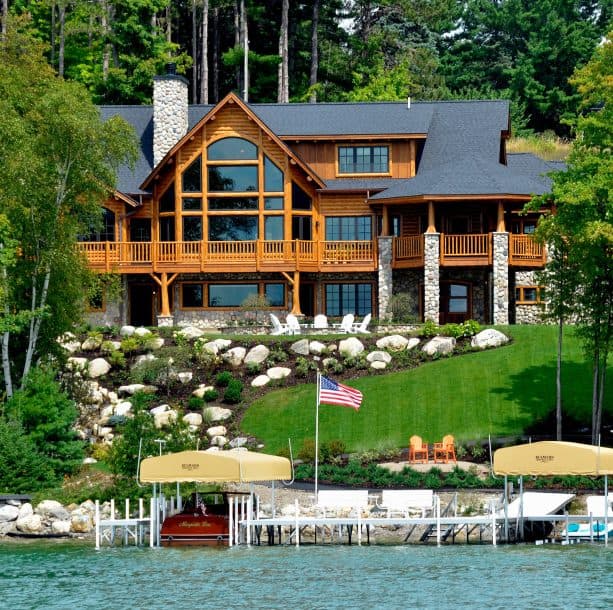
If you want to create color coordination for your log cabin exterior, using the asphalt shingles roof is recommended. It’s because that kind of roof is versatile and flexible. It can fit any design and be finished in any color to accentuate the log siding.
Look how these black-colored asphalt shingles complement the medium tone log siding.
After all, black is the right color you should choose if you want to add elegance and sophistication to your property. Black will make your log cabin look prominent.
But, the most important reason is black can absorb heat. So black can be the best bet for a log cabin situated in a colder area, where sunlight is highly appreciated.
When asphalt shingles are finished in black, they can be the best energy-efficient material.
Maintaining the temperature of the log cabin inside is the major concern because most log cabins are located in the woods or mountains, where the temperature can be a few degrees lower than the other areas.
Asphalt shingles can keep the rooms inside warm by trapping the heat inside and circulating it to the insides of the cabin. This roofing material is not only able to make your property look warm and inviting, but it can also give warmth to you inside.
In this three-story log cabin, a dark tone roof will make it appear more majestic. Contrary to popular belief, black will not make every single thing smaller. If it is combined properly like this, it enhances the grande look of an exterior.
8. Standing Seam Metal Roof in Patina Finish for a Log Cabin
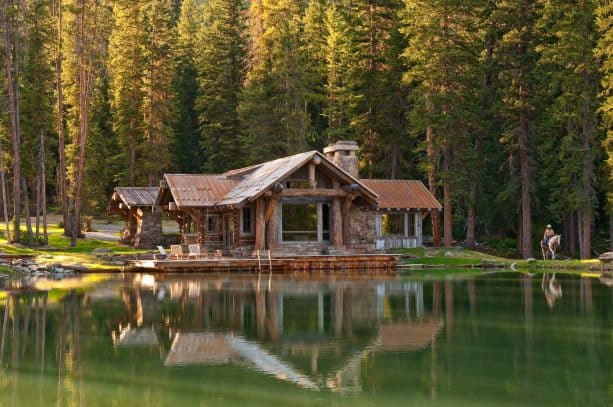
In the old days, standing seam metal roof was only used in commercial and agricultural buildings. Nowadays, many private buildings, including log cabins, are completed with this kind of roof.
In fact, standing seam is one of the most common types of metal roofs. Aluminum, Galvalume, and Galvanized steel are the most commonly used materials, coated for extra protection and color.
It appears that the roof used for this log cabin is Zinc Patina Standing Seam Metal Panels in gable style.
Who needs dark brown color for a roof if you can have it in a patina finish like this?
This finish makes the log cabin looks rustic and traditional, and it nicely matches the log and stone walls of the exterior.
A standing seam metal roof is an excellent material in the northern climate because it is incredibly resistant to ice formation and snow.
The ice will slide right off, not building up to create ice dams. Plus, this roofing material can also withstand strong winds, making it a perfect choice for log cabins in a blizzard climate.
9. Corrugated Metal Roof in Green Color for a Large Log Cabin
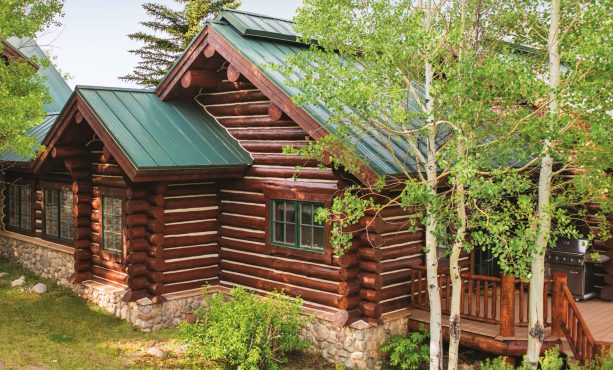
Have you ever wondered why log cabins are usually completed with a green-colored roof?
If you want to choose the right roof for your log cabin, consider using green to make it the same as many other log cabins.
Green is a trendy color for log cabin roofing because it’s natural and resembles forests. The natural color palette can fit any log siding color you choose.
Green log cabin roofs can be used in different ways to achieve different results. For instance, pair a green corrugated metal roof with green trim, as you see in this picture, to get a more subtle contrast that enhances the visual of the exterior.
Combine the deep and rich green metal roof with dark polished log siding to get a dramatic result that makes your property stand out in the crowd.
If your log cabin is situated in the deep woods, surrounded by towering trees, painting the corrugated metal roof in green can be the best solution, because it means you can make your log cabin blend seamlessly with its surrounding.
What’s more natural than a building that can harmonize with nature?
In fact, green will make your metal roof less modern and make it look more natural instead.
One of the major reasons people choose a corrugated metal roof for the log cabin is because it is quiet. Unlike the usual metal roof that can amplify the sound of falling rain, this type of roof is silent.
Remember, not everyone finds the sound of falling rain is soothing. If you’re one of them, consider installing this metal, especially in a large log cabin like this, where it would be a problem when the rain falls.
10. Worn-out Steel Log Cabin Roof in a Rustic Style
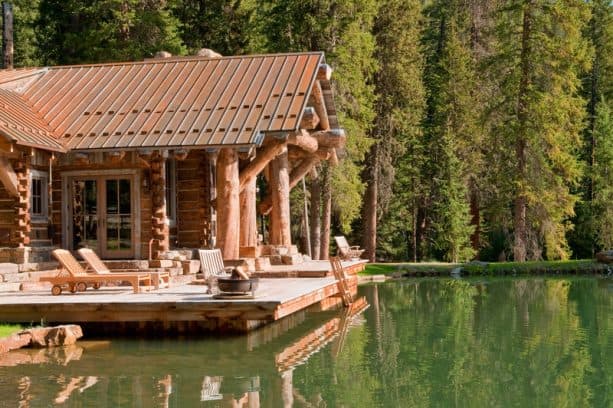
A worn-out and rusty metal roof color can be your best solution to achieve a traditional rustic look as an alternative to green color.
The more worn-out your metal roof, the more traditional and rustic it looks. It’s because the rust on the roof will match the log siding and log columns of the cabin, creating cohesion in a brown color.
The great thing is, rust on the roof is basically a great thing. It can be a protective layer for the roof, so it can last longer even though it has to deal with snow and rain.
If you want to have this kind of metal roofing, it is better to match it with the rest of your log cabin exterior.
This is basically the opposite of the previous picture. In the earlier pictures, you tried to make your log cabin blend more seamlessly to the nature around; this one, you attempt to make it look contrast and prominent against the greeneries.
Look how the brown-colored house, including the rusty metal gable roof, the brown log siding and columns, the brown trim, and even the brown outdoor furniture, look odd against the green lake, green grass, and green trees surrounding.
11. Combination of Cedar Shakes and Metal Roof in a Log Style Cabin
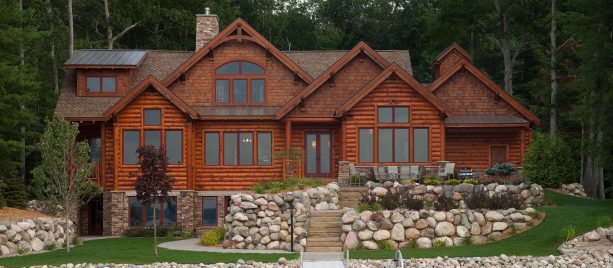
There’s nothing to describe this log cabin other than rustic.
The designer managed to create a rustic approach through the shaker style, the logs, stonework, and dark metal roofing. This building also features a well-proportioned design that delivers an inviting and rich appearance.
Some parts of this log cabin have metal roofing.
Considering the expensive cost of installing a metal roof, it would be wiser if it’s only installed in some parts of the log cabin, especially if you’re on a tight budget. This way, you can still have the benefits of the metal roof without having to spend much money.
A dark-toned metal roof can be beneficial to retain heat from the sun and make the build-up snow on the roof easily melt so it won’t weigh down the log cabin.
The gable cedar shakes roof also makes this log cabin look more traditional.
Actually, cedar shakes are no longer common for the log cabin roof. But we can’t deny that basically, there are many good reasons why you should incorporate it in your log cabin exterior.
Cedar shakes have natural preservatives that make them resistant to insect damage, UV rays, and moisture. Moreover, they are also wind resistant, which makes them a better option for a log cabin in a blizzard climate.
Cedar shakes are adaptable to varied climatic conditions, even the tough ones.
Heavy rain and snow won’t matter to them. Plus, compared to many other roofing materials, cedar is less susceptible to moss growth, making it the best low-maintenance roofing option.
Cedar shakes can be factory-treated to be fire resistant and fungus resistant. With such protective characteristics, cedar is the kind of material that can last for a long time.
12. Slate Log Cabin Roof in Gable Style

This small log cabin is seemingly completed with a gable slate roof, a traditional option for a roof that somehow still managed to make the property look classic, warm, and inviting.
Despite the fact that many people don’t use slate anymore for their log cabin roofs, slate does have its own advantages.
Don’t worry about the fire if you have a slate roof for your log cabin. A slate roof is absolutely fire resistant as a natural stone product, unlike other roofing materials.
If your log cabin is located in the forest or wood, the area may be prone to wildfires and bushfires during the summer because the dried grass and wood can create a fire. Slate roofs can be your best solution to protect your log cabin.
Apart from fire, a slate roof can also resist high temperatures and heat. So even during the summer days, your log cabin will stay cool inside. It means you can cut the energy bill. It’s also good to know that slate is environmentally friendly.
Slate is a natural material that needs very little processing, unlike asphalt shingles and metal roofing.
See how the finish of this slate roof complements the medium tone log siding. If you combine slate and log for the exterior, your log cabin will surely deliver a perfectly natural look because it is mostly made of natural elements.
13. Englert Kynar Ultra-Cool Low Gloss Metal Log Cabin Roof
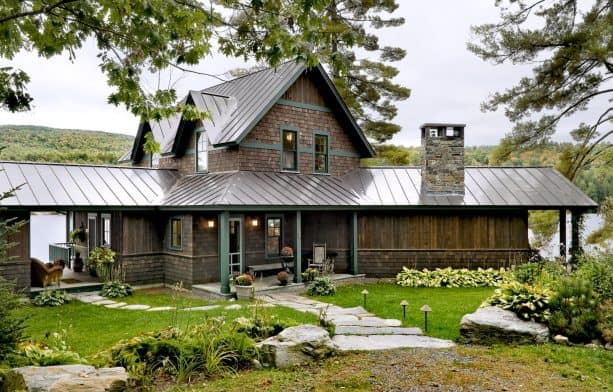
Instead of painting the roof in green to create a natural look and resemble a forest, the designer painted the trim green. It gives almost a similar effect to the green roof, but in a subtler way.
The roof is finished in dark color. It’s an Englert Kynar Ultra-Cool Low Gloss metal roof in medium bronze finish, the kind of metal roof that will give a luxurious look to your log cabin.
This kind of metal roof is your best option for those who have a log cabin and live in rainy and heavy snowfall areas. It’s because the surface of the metal sheet is slippery and hard by nature, which makes it difficult for water and snow to make a grip.
To top it off, this metal roof has a dark tone. It doubles the benefits of metal roofing.
FYI, dark tones like this on a metal roof will quickly warm to the sun, making the snow melt quicker. It’s recommended to add another extra layer of PVDF coating that can help reflect back more sunlight and encourage HVAC performance.
With such a roof in your log cabin, during the heavy snow, it will reduce the weight on your property.
14. Green Painted Metal Log Cabin Roof
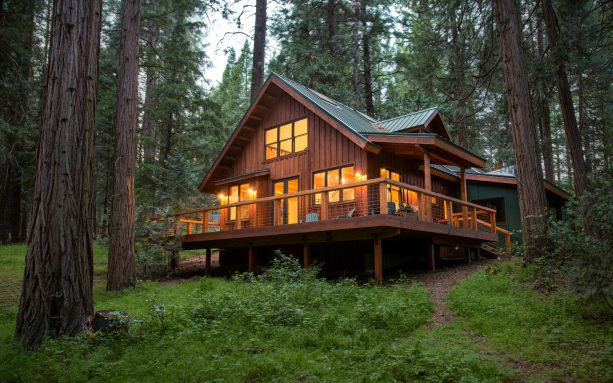
Another green metal log cabin roof here.
Installing a metal roof in your rustic log cabin may sound weird because the element clashes. The log siding that’s often used in a log cabin delivers an authentic traditional look, while the metal roof pulls off a modern style.
If you don’t want to have a transitional exterior, it’s better to make your metal roof look more traditional.
The most possible way to traditionalize a metal roof is by painting it in green color. Basically, green is not genuinely traditional, but it represents nature very much.
In a rustic style, where nature is highly appreciated, green has become a traditional color. Look how the green metal roof complements the wood siding. They blend harmoniously with the surrounding nature.
Moreover, this gable roof has a dark green finish. The dark tone will help absorb more heat. Even though the result is not as strong as black, dark tones like this will surely help make your log cabin warmer inside.
This shade is an excellent alternative if you think black is way too modern for your traditional rustic log cabin, but you want to get the insulating advantage.
15. Choosing Materials for Log Cabin Roof
Another thing that you should consider when choosing a log cabin roof is the material.
Actually, the most cost-effective choice is asphalt shingles that can be upgraded to a more dimensional architectural shingle to deliver a distinctive look.
Metal roofs are also quite popular for cabins because they can be both durable and pretty at the same time.
Other than that, here are the other popular materials for log cabin roofs:
- Slate. It used to be the most popular option for log cabins, but it has fallen out of vogue due to its high cost and heavyweight. Despite that fact, slate is a good choice if you want a durable roof. It can last even a century. Plus, slate is also resistant to mildew and mold, apart from being fireproof too.
- Cedar Shakes. The rich appearance of this type of roof can’t easily be imitated by synthetic materials. Yet, due to the intensive installation process and high material cost, cedar shakes are quite pricey. If you can afford them, they are worth it. Cedar shakes can stand against deterioration with over 50 years of life expectancy with proper maintenance.
- Clay. You probably didn’t see any clay log cabin roof in the pictures above, but this roof has been used for centuries. Clay roofs are able to create cool air inside, making it more comfortable inside. With the cooling effect, clay roofs can indeed reduce energy bills; thus, they are considered a sustainable material. Clay roofs don’t only come in traditional terra-cotta color, but they can also mimic shakes or slates perfectly. These days, tiles of clay roofs are not handcrafted anymore. They are not machine molded and sealed to lower moisture absorption.
Leave a Reply